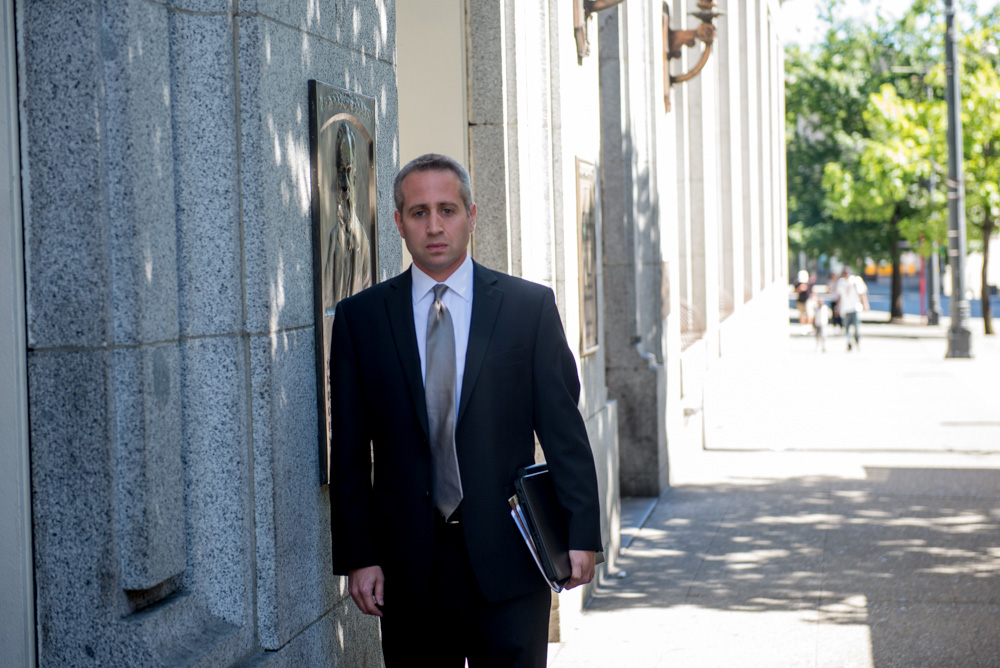In 2012, a 69-year-old black man killed a younger white man during an altercation. At trial, King County prosecutors argued that Lovett Chambers fatally shot Michael Hood without provocation outside a West Seattle bar.
But Chambers’ defense team, which included Ben Goldsmith, an eight-year veteran of the Public Defenders Association Division, gave another account of the shooting. They argued instead that Chambers killed the 35-year-old after Hood and another man, Jonathan Vause, shouted racial epithets and threatened Chambers with a shovel. Chambers shot Hood to protect himself from bodily harm, says Goldsmith.
The jury ultimately disagreed. In April, Chambers was convicted of manslaughter. According to Goldsmith, there were no African-Americans on the jury. And for him, that verdict remains frustrating. “It’s impossible for me to believe that if Mr. Vause was black and Mr. Chambers was white that this jury would have come out with the same outcome,” says Goldsmith.
This wasn’t the first time Goldsmith felt he had witnessed injustice at the hands of a skewed jury, but it was the one that moved him to volunteer for a difficult task: to prove that people of color are underrepresented at jury trials in King County.
Starting this month, Goldsmith, an assistant supervisor at the Public Defender Association Division, and as many as 15 other PDA attorneys will begin filing “declarations” documenting the racial makeup of each group of jury pools during trial proceedings at King County Superior Court. The declarations will be entered into the official trial record and the results compiled at some later date, Goldsmith says.
King County court administrators do not take account of the demographics of who is sent a jury-duty summons, or who ultimately shows up to serve. They’re not alone. A spokesperson for the Washington State Administrative Office of the Courts says the state does not currently track that information either. Nor are administrators currently aware of any county or municipal court system in the state that does.
This is a significant lapse, says Goldsmith, referring to requirements that jurors are selected from a “fair cross section” of the community.
Anita Khandelwal, supervisor of the Public Defender Association’s Racial Disparity Project, agrees with him. “The system is supposed to work where you have all of that perspective of a community in the room, and the fact that we don’t seem to be getting some of that perspective at trials is a challenge,” she says.
Even if Goldsmith and Khandelwal are correct, it is difficult to know what changes can or should be made to increase diversity in jury pools.
The complicated process of recruiting a jury pool is by design at least somewhat colorblind, and also extraordinarily difficult. To build a pool of trial jurors, King County administrators draw from lists of registered voters, as well as from the group of county residents who have state driver’s licenses and identification cards. According to a spokeswoman for the King County Court Administrator’s Office, names are drawn from the database at random by a computer program.
”The jury acts as the conscience of the community and does so best when it reflects the composition of the community.”
King County mails 114,000 jury summons annually. At no point in the process is the racial makeup of that list accounted for, administrators say. In the end, the average monthly response rate to those summons hovers between 30 and 35 percent.
For Dave Chapman, the interim head of the recently formed King County Department of Public Defense, that number isn’t high enough. “From my perspective, 35 percent is very low for civic duty,” he says.
This issue hasn’t gone unnoticed by others in the legal community. A 2000 Board for Judicial Administration report called for efforts to “increase participation in jury service by sectors of society that traditionally have not participated fully.”
Chapman says that the Department of Public Defense is generally supportive of Goldsmith’s initiative to amass this data. “We want to make sure that the folks that are going to show up and serve on a jury reflect the norms of our community, ” he says.
Still, the department has no plans to make the jury declarations mandatory for attorneys across its four divisions.
Asked for comment on the jury diversity issues and Goldsmith’s effort, the office of King County Prosecuting Attorney Dan Satterberg released a statement saying that “The jury acts as the conscience of the community and does so best when it reflects the composition of the community. We are happy to work with the court on efforts to increase the participation of our citizens in this important civic duty.”
Two representatives from that office attended a meeting with Goldsmith, Khandelwal, and other public defenders Monday morning to discuss methods for capturing data and addressing the issue of minority representation on juries. Following the meeting, a preliminary agreement was reached. Pending final approval by a panel of King County judges, the agreement could mandate that court administrators gather the info directly from those who report for jury duty.
While encouraged, both Khandelwal and Goldsmith say the agreement represents the beginning of a long process. The declarations, Goldsmith says, are “just a first step.”
news@seattleweekly.com








